Is It Smart To Buy SouthState Corporation (NASDAQ:SSB) Before It Goes Ex-Dividend?
It looks like SouthState Corporation (NASDAQ:SSB) is about to go ex-dividend in the next three days. The ex-dividend date is usually set to be one business day before the record date which is the cut-off date on which you must be present on the company's books as a shareholder in order to receive the dividend. The ex-dividend date is an important date to be aware of as any purchase of the stock made on or after this date might mean a late settlement that doesn't show on the record date. Thus, you can purchase SouthState's shares before the 10th of August in order to receive the dividend, which the company will pay on the 18th of August.
The company's next dividend payment will be US$0.52 per share, and in the last 12 months, the company paid a total of US$2.08 per share. Last year's total dividend payments show that SouthState has a trailing yield of 2.7% on the current share price of $78.35. We love seeing companies pay a dividend, but it's also important to be sure that laying the golden eggs isn't going to kill our golden goose! So we need to investigate whether SouthState can afford its dividend, and if the dividend could grow.
See our latest analysis for SouthState
Dividends are typically paid from company earnings. If a company pays more in dividends than it earned in profit, then the dividend could be unsustainable. Fortunately SouthState's payout ratio is modest, at just 28% of profit.
Companies that pay out less in dividends than they earn in profits generally have more sustainable dividends. The lower the payout ratio, the more wiggle room the business has before it could be forced to cut the dividend.
Click here to see the company's payout ratio, plus analyst estimates of its future dividends.
Have Earnings And Dividends Been Growing?
Companies with consistently growing earnings per share generally make the best dividend stocks, as they usually find it easier to grow dividends per share. If earnings decline and the company is forced to cut its dividend, investors could watch the value of their investment go up in smoke. For this reason, we're glad to see SouthState's earnings per share have risen 19% per annum over the last five years.
Another key way to measure a company's dividend prospects is by measuring its historical rate of dividend growth. In the last 10 years, SouthState has lifted its dividend by approximately 11% a year on average. It's great to see earnings per share growing rapidly over several years, and dividends per share growing right along with it.
Final Takeaway
Should investors buy SouthState for the upcoming dividend? Typically, companies that are growing rapidly and paying out a low fraction of earnings are keeping the profits for reinvestment in the business. This strategy can add significant value to shareholders over the long term - as long as it's done without issuing too many new shares. In summary, SouthState appears to have some promise as a dividend stock, and we'd suggest taking a closer look at it.
On that note, you'll want to research what risks SouthState is facing. Be aware that SouthState is showing 2 warning signs in our investment analysis, and 1 of those can't be ignored...
Generally, we wouldn't recommend just buying the first dividend stock you see. Here's a curated list of interesting stocks that are strong dividend payers.
Have feedback on this article? Concerned about the content? Get in touch with us directly. Alternatively, email editorial-team (at) simplywallst.com.
This article by Simply Wall St is general in nature. We provide commentary based on historical data and analyst forecasts only using an unbiased methodology and our articles are not intended to be financial advice. It does not constitute a recommendation to buy or sell any stock, and does not take account of your objectives, or your financial situation. We aim to bring you long-term focused analysis driven by fundamental data. Note that our analysis may not factor in the latest price-sensitive company announcements or qualitative material. Simply Wall St has no position in any stocks mentioned.

